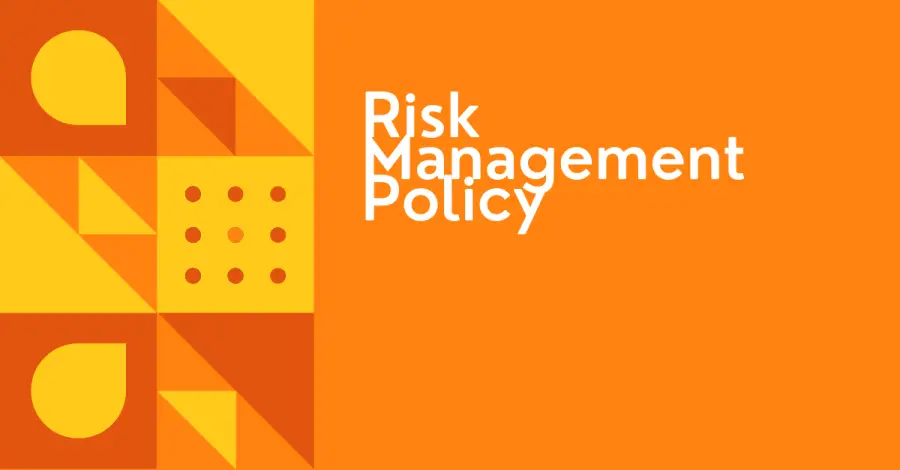A risk management policy is a document that outlines the procedures and guidelines for assessing, controlling, and managing risks. This blog post will provide 5 tips to help you create an effective risk management plan.
1) Identify your risks- Conduct an assessment of your organization’s potential vulnerabilities by identifying all aspects of its operations that are at risk to external or internal forces. Consider who could potentially pose a threat (current or future employees), what they might be after (money, confidential information), and how they would go about it (hacking).
2) Assign responsibility- Assign responsibility for assessing, monitoring, evaluating, correcting any identified problems with each operation within your organization based on their level of vulnerability.
3) Implement policies and procedures based on those worst outcomes to mitigate their effect on your company.
4) Create a plan with contingencies for each worst-case scenario detailed in.
5) Document everything by use of the organization risk register.
a)Identify your Risks- Conduct an Assessment of your Organization’s
In order to conduct an assessment of your organization’s risks, you’ll need to identify the ways your business or enterprise might fail. In other words, which are the dangers that exist for this company? Furthermore, you’ll want to classify these failures as catastrophic events, major incidents cause by unsafe operations or incompetence which may damage the company’s reputation with customers and suppliers but not be systemically injurious to it in terms of capital trust assets or physical assets; typical operating ills such as chronic low-quality service levels; aspirational objectives not yet achieved; management practices inconsistent with success in their industry sector.
Firms’ evaluation of risks will support understanding of relevant strategic risks, their likelihood and impact taking into account the importance of prevention controls that subject risk levels to a range and model adopted and recommended for use.
According to an organization that maintains adequate Risk Management Policies should adequately address goals and commitments. Risk management framework and policy provide the responsibility for management to undertake systematic risk assessments exercises to ensure the outcome of the process is well articulated and presented in risk management reports.
There exist various risks like political risks arising from a change in a political environment that might affect business conditions of compliance. Controls will be able to address various objectives of the business i.e hospital environment.
b)Assign Responsibility
Assign responsibility for assessing, monitoring, evaluating, correcting any identified problems with each operation within your organization based on their level of vulnerability. The more narrowly drawn the objectives and scope of responsibility, the easier it becomes to assign responsibility while still meeting your organization’s needs.
Develop a risk management plan and designate a team to implement it. This should include individuals with the required knowledge, skills, and experience to assess and manage risks.
A manager at the top may be tasked with implementing risk-management policies, but there is no single manager that’s solely accountable for it. Indeed, the practice of assigning centralized responsibility within an organization is rare because risk management looks different from all angles depending on an employee’s vantage point, as some responsibilities are assigned out to each department or level of the organization.
c) Implement Policies and Procedures
Implementation occurs with the use of framework tools. These tools ensure that risk management activities are carried out seamlessly without any difficulty.
There are different framework tools that can be used to implement risk procedures and policies like:
– Implementation matrix: measures the organizational impact and benefits of implementing a change. The implementation matrix provides an assessment tool to help identify, prioritize and plan for changes; thereby reducing the associated risks. This tool is particularly useful when planning changes or assigning responsibilities such as selecting compensating controls or preparing an error-proof process flowchart.
– Failure modes and effects analysis (FMEA): looks at all potential failures in a system, its functions, subsystems, etc., from the perspective of how they contribute to the failure of the whole.
–Key risk indicators:- Key risks help provide a framework for identifying and prioritizing the risks that should be managed as part of an enterprise-wide risk management program. Risk indicators, on the other hand, represent the data that serves as a precursor to risk identification.
Key risk indicators can be listed as follows:
- -Claim frequency;
- -Expected loss;
- -Loss ratio;
- -Loss ratio overtime period X (Royalty); and
- -Lodging claim days.
-Risk Control Self Assessment( RCSA):-Risk Control Self Assessment acts as a framework tool for management. They are also known as risk assessment or risk inspection frameworks. A Risk Control Self Assessment typically involves the following five steps:
Risk Management is a process that needs to be planned and executed by everyone in an organization to ensure it is effective, with all staff ‘owning risk’, highlighting risks, and reducing them. This process not only assesses what can happen but also how likely it is to happen and who would suffer if harm does occur – so it is about more than just assessing the hazards we face. It takes into consideration quality assurance practices involved in product manufacturing, occupational health and safety measures taken during site operations, and employee welfare whilst engaging with the company.
d)Create a Risk Management Policy with Contingencies for each Worst-Case Scenario
It can be difficult to think of all possible contingencies for everything that might go wrong. That being said, it’s good practice to have an estimate of at least one worst-case scenario in mind for any plan. If you’re thinking about starting a small business, it’s always better to start with the possibility of failure in mind- not because this strategy will make massive success more likely, but because it will give you peace of mind if things do go badly.
What are your worst-case scenarios? What are the likely outcomes based on projected revenues? Think through each difficulty/risk and tie these risks to your contingency plan- what would happen if X happens? What would you do then?

e)Document Everything by use of the Organization Risk Register.
The organization risk register or ORR is a document that a company can use to help strategize for the future and plan specifically what they might want to do if something catastrophic happens. The risk register will have different sections with specific information about anything from natural disasters, accidents, hacking, etc.
This risks worksheet is an easy way for you to keep track of all the risks documented by your department. This helps bring more of an organized idea of what your workflow is and how it affects other departments of the company that document their own risks. Once you start documenting everything on this form then filling out the form becomes more and more automatic and easier as time goes on.
Conclusion
A risk management policy can help your organization avoid costly mistakes. Implementing a risk management plan is an essential step for any business that wants to thrive in today’s competitive marketplace. As you create this document, consider the 5 guidelines we outlined above and how they might apply to your particular situation. We hope these tips have helped! Let us know if you need some assistance with creating a risk management plan or want additional guidance on implementing it at your company.
Chris Ekai is a Risk Management expert with over 10 years of experience in the field. He has a Master’s degree in Risk Management from University of Portsmouth and is a CPA and Finance professional. He currently works as a Content Manager at Risk Publishing, writing about Enterprise Risk Management, Business Continuity Management and Project Management.

